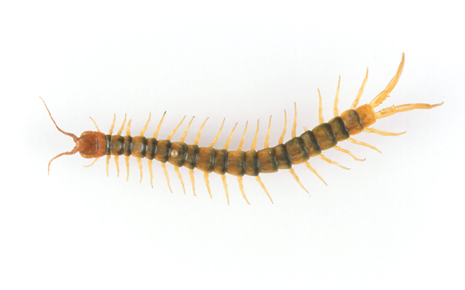Chilopoda - The Centipedes
Centipedes are an ancient group of animals, evolving alongside the first insects hundreds of millions of years ago, long before any other creatures had considered living on the land. They are distantly related to insects, possessing antennae and similar mouth-parts. However, the number of legs they have places them in a class of their own. Centipedes are active carnivores, feeding on whatever prey they can subdue. In the northern half of the U.S.A., centipedes are small and harmless. Their size increases the closer you travel towards the equator. While species that live in temperate climates are usually small, in the tropics many centipedes reach lengths of well over a foot and are capable of feeding on small rodents. All species capture their prey with the aid of venom released from their "fangs". These "fangs" are actually a pair of specially modified legs called gnathopods. They are hollow and contain venom sacs. Although you won't die from the venom (usually), large Scolopendra species can inflict incredibly painful bites. Most centipedes are nocturnal, hunting at night. They are secretive in most other habits as well. Females excavate cavities in soil or rotten wood and lay a mass of eggs, which they often coil around and protect. Young are sometimes looked after until they can fend for themselves. The 4 orders that comprise the Chilopoda are: Scutigeromorpha, Lithobiomorpha, Geophilomorpha and Scolopendromorpha.
 Tiger Centipede (Scolopendra polymorpha)
Tiger Centipede (Scolopendra polymorpha)
![]() Giant Centipede (Scolopendra sp.)
Giant Centipede (Scolopendra sp.)
